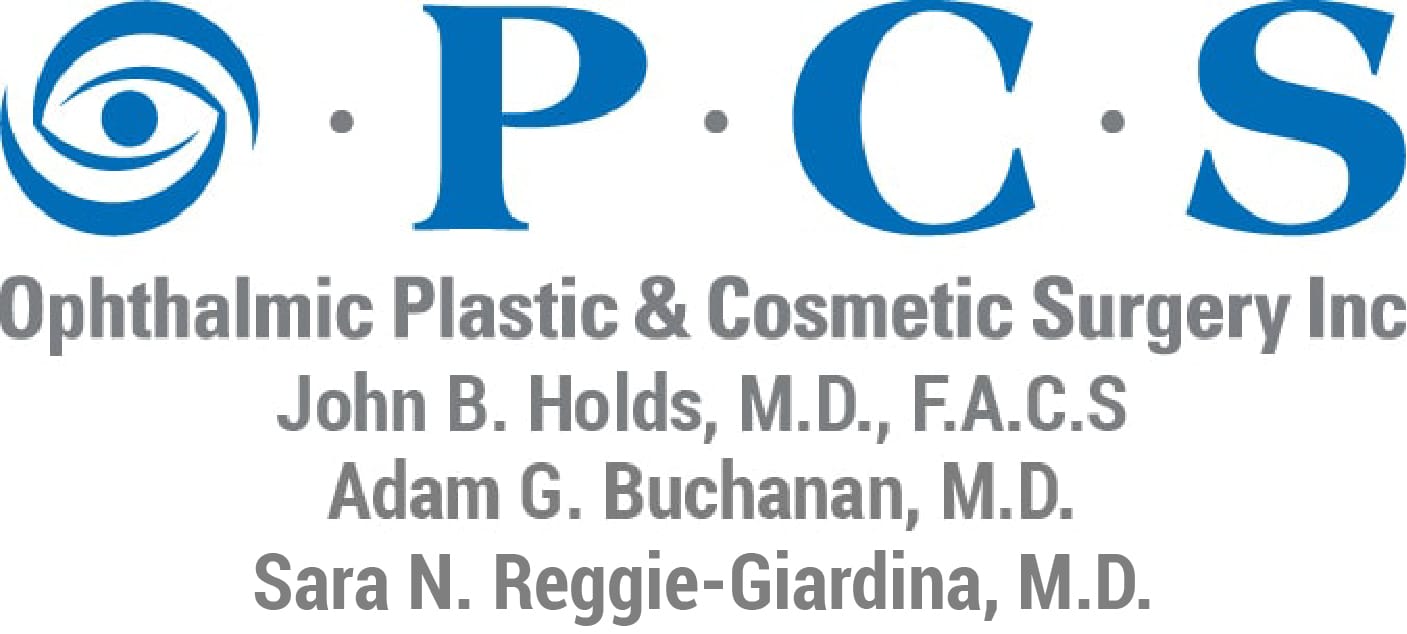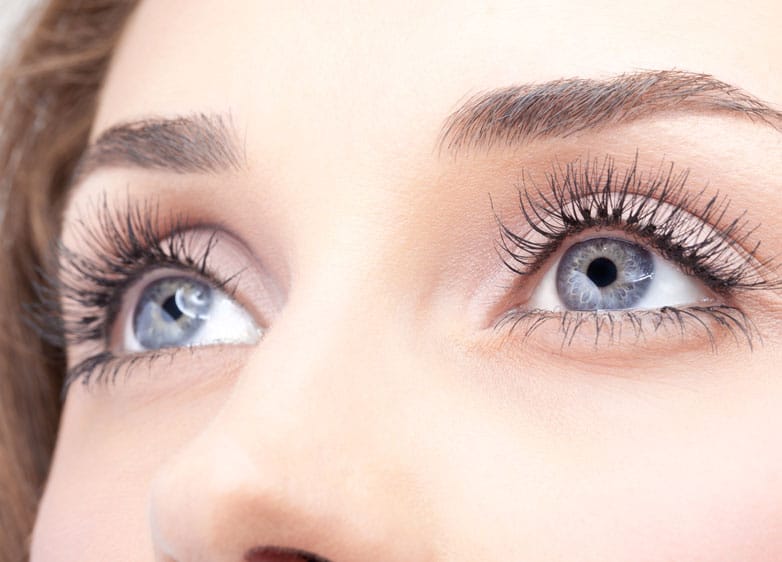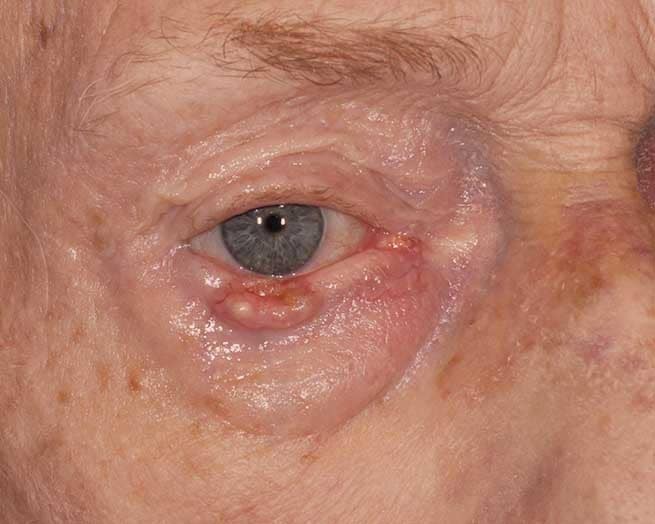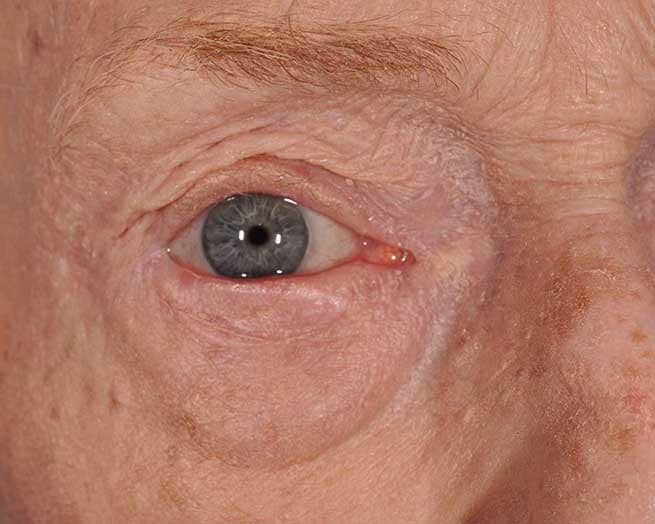Eyelid Cancer Reconstruction in St. Louis, MO
What is Eyelid Cancer Reconstruction?
Eyelid Cancer Excision and Reconstruction may be necessary if you have developed skin cancer on your eyelids. Unfortunately, these skin cancers are relatively common if you have had a lot of exposure to the sun.
Reconstructive surgery helps to restore normal function and appearance to the lids after the skin cancer has been removed. If you have been diagnosed with eyelid skin cancer, you may be an excellent candidate for Eyelid Cancer Reconstruction in St. Louis to correct the condition and restore your health.
Skin cancers must be completely removed, preserving and restoring the delicate tissues of the eyelids. Our team specialize in preserving as much of your lid structure as possible while completely removing the cancerous tissue. Luckily, today’s surgeries work on the microscopic level to ensure that no more tissue is removed than absolutely necessary.
Eyelid Cancer Reconstruction Before and After
the Types of Skin cancer That can cause Eyelid Cancer
There are four principal types of skin cancer:
- Basal cell carcinoma
- Squamous cell carcinoma
- Malignant melanoma
- Sebaceous cell carcinoma
Basal cell carcinoma is the most common, and the last two types are relatively rare on the eyelids. The good news is that most skin cancers can be readily and successfully treated as long as they are caught early.
It is important to see a doctor right away if you suspect that you have skin cancer on your eyelids. Unusual new enlarging skin growths, with or without pigment are suspect. Crusting, bleeding or ulceration are big warning signs!
What our patients have to say
“I’ve been seeing Dr Holds for 28 years by far the best doctor I’ve come across and would highly recommend him to anyone looking for eye surgery or plastic surgery” -Rod C.
“Dr. Holds and his staff are the best. I would highly recommend them. They insure you are happy with anything they do. They produce great results.” Patti H.
What is Involved in Eyelid Cancer Reconstruction?
The aim of Eyelid Cancer Reconstruction is to reconstruct the eyelid after ensuring the cancerous tissue has been excised. You may have already had your skin cancer removed by another surgeon, but you feel that you no longer look your best as a result. This is where our team at Ophthalmic Plastic and Cosmetic Surgery, Inc. can come in.
The usual process in treating suspected eyelid cancer is to first obtain a biopsy to establish the diagnosis. This is generally done during an office visit. Once we have a diagnosis, a decision is made about how to treat the problem. We often work with a specialist dermatologist who performs a technique called Mohs excision to ensure complete excision of the skin cancer with a minimum amount of normal tissue excision.
In this situation, you visit the office of the Mohs surgeon on the day of surgery, and they complete the removal of cancer. You then come to our surgery center where we complete your reconstruction to be as aesthetic and functional as possible.
We sometimes perform the excision in our operating room, monitoring the margins to ensure complete excision with a technique called a “frozen section.” In this case, we can proceed immediately to the reconstruction.
You may have undergone surgery elsewhere that left you with lids that turn outward or inward, or you may no longer have the ability to fully close your eyes. All of these issues and others can potentially be addressed with Eyelid Reconstruction.
We usually do not perform cosmetic surgery such as cosmetic blepharoplasty, midface lift, or laser skin resurfacing as part of the initial eyelid cancer reconstruction, but we often perform these procedures later for patients who wish it.
Each Eyelid Cancer Reconstruction is individual, but our team is committed to preserving your vision, making sure that your eyelids function properly, and improving the appearance of your eyes.
What are the different types of skin cancer that can cause eyelid cancers?
There are three main types of skin cancer — basal cell carcinoma, squamous cell carcinoma, and melanoma. When it comes to the eyelids, another much rarer skin cancer known as sebaceous cell carcinoma also comes into play.The eyelids, because they are exposed to the sun all the time, are particularly susceptible to the development of skin cancer. Fortunately, these eyelid cancers typically are basal cell and squamous cell carcinomas, not the more dangerous melanoma.
Here’s what differentiates these four types of skin cancer:
- Basal cell carcinoma — Eight out of every 10 skin cancers are basal cell carcinomas, making this form of skin cancer far and away the most common. They grow in the lowest layer of the epidermis, the basal cell layer. These cancers usually develop on sun-exposed areas, especially the head and neck. They tend to grow slowly, and it is rare that they spread to other parts of the body. If left untreated, basal cell carcinomas can grow into nearby areas and invade bone or other tissues beneath the skin, making removal potentially disfiguring.
- Squamous cell carcinoma — Squamous cell carcinoma is the second most common form of skin cancer. It forms in the squamous cells that make up the middle and outer layer of the skin. Most squamous cell carcinomas result from prolonged exposure to ultraviolet radiation from the sun or tanning beds or lamps. Unlike basal cell carcinomas, squamous cell carcinomas can occur in more wide-ranging locations. Although more common on the sun-exposed skin on the backs of the hands, the ears, the scalp, and the lips, this form of skin cancer can occur anywhere on the body, including inside the mouth and on the genitals. Not considering life threatening if treated early, like basal cell carcinoma, it can also be disfiguring. If it spreads, it can be life threatening.
- Melanoma — Most people assume there is just “melanoma.” There are actually four different types of this most dangerous form of skin cancer.
- Superficial spreading melanoma — This is the most common form. It can arise in an existing mole or appear as a new lesion. When it forms in a mole already on the skin, it tends to grow on the surface for a period of time before penetrating more deeply. It is most likely to occur on the torso in men, the legs in women, and the upper back in both sexes. Superficial spreading melanoma appears as flat or slightly raised and discolored, asymmetrical patches with uneven borders.
- Lentigo maligna — This form of melanoma often develops in older people. It also grows close to the surface skin in the beginning. This form typically develops on sun-damaged areas of the face, ears, arms, and upper torso. Lentigo maligna appears as flat or slightly raised, blotchy patches with uneven borders.
- Acral lentiginous melanoma — This is the most common form of melanoma found in people with darker skin tones, including those with African ancestry. It often forms in areas that are not easy to spot — under the fingernails or toenails, on the soles of the feet, or on the palms of the hands. It appears as a black or brown area.
- Nodular melanoma — This is the most aggressive type of melanoma. It makes up 10-15 percent of all cases. These tumors grow deeper into the skin more rapidly than other types of melanoma. They are invasive tumors, meaning they’re likely to already have reached the deeper layer of skin by the time it is diagnosed. These are found most frequently on the torso, legs, and arms, and on the scalp in older men. These appear as a bump on the skin, usually blue-black in color.
- Sebaceous cell carcinoma — Sebaceous cell carcinoma is quite rare compared to the more well-known three cancers listed above. But it is particularly involved with the eyelids. This form of skin cancer begins in an oil gland (a sebaceous gland) in your skin. Sebaceous cell carcinoma may begin as a painless lump or thickening of the skin on the eyelid. As it grows, the cancer may bleed or ooze. Although rare, sebaceous cell carcinoma is more aggressive, as it can spread to other areas of the body.
What are the risk factors for developing skin cancer on the eyelid?
A risk factor increases your chances of developing cancer. While risk factors themselves do not cause cancer, if you have any of these you need to regularly see your dermatologist so that he or she can keep tabs on any suspicious lesions on your skin, including your eyelids.These are risk factors for developing eyelid cancer:
- Exposure to UV radiation — Exposure to the sun’s ultraviolet radiation plays a role in developing all of these skin cancers. People who live in areas with year-round bright sunlight have a higher risk for developing eyelid cancer. This is also true if you’ve been a regular at a tanning parlor.
- Fair skin — Melanin is the skin’s protection mechanism against UV radiation. That’s why our skin darkens after sun exposure; the skin is protecting itself. People with less melanin in their skin have less protection. People with light hair and light-colored eyes who have skin that doesn’t tan but instead freckles or burns easily are at higher risk for developing eyelid cancer.
- Gender — White men are developing these cancers at a higher rate.
- Age — Most basal cell and squamous cell carcinomas appear after the age of 50.
- A history of sunburns — All skin cancers develop from repeated, accumulating sun exposure and damage. This is especially true of basal cell, squamous cell, and sebaceous cell carcinomas. Melanoma tends to be linked to extreme, peeling sunburns. Each of those sunburns that occur in a person’s life doubles their chance of developing melanoma later in life. Melanoma, however, is rare in eyelid cancer.
- Previous skin cancer — If you’ve had any form of skin cancer that places you at much higher risk for developing another skin cancer. For instance, about 35 to 50 percent of people who are diagnosed with one basal cell carcinoma will develop a new cancer within five years.
What is recovery like after eyelid cancer reconstruction?
Unlike cosmetic eyelid surgery, which involves a relatively easy recovery, reconstructive eyelid surgery recovery is more involved. Patients usually need to wear an eye patch for at least the first 24 hours. Recovery may take up to two weeks for the bruising and inflammation to fully subside. From there, the extent of the procedure will dictate the remainder of your recovery.Once our Ophthalmic Plastic & Cosmetic Surgery surgeon meets with you during your consultation, we can give you a better idea of the extent of the reconstruction needed and your corresponding recovery.
Will I have scarring after eyelid cancer reconstruction?
Schedule A Consultation For Eyelid Cancer Treatment in MO
If you have already had skin cancer removed from your lids but want to improve function and appearance, or if you believe you have eyelid skin cancer, contact our office right now at (314) 567-3567 to discuss how we can help you to restore your health and look your best.





